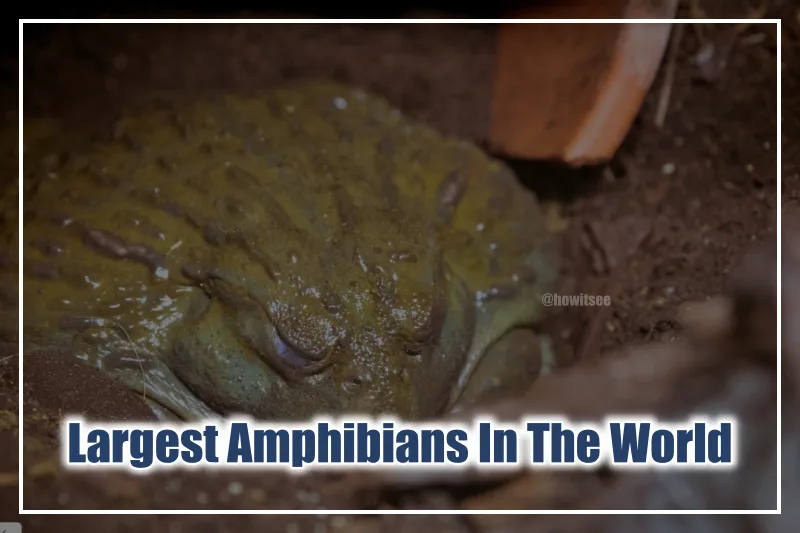In the recent world statistics, Amphibians comprise the most endangered species of all other classes in the Animal Kingdom.
With many species driven to the verge of extinction by anthropogenic activities, they are almost few or no individuals left in the wild in the case of certain species.
Therefore, to introduce you all to a few of the amphibians before they go extinct, we bring to you our today’s article, “Top 10+ Largest Amphibians in the World.”
Top 10+ Largest Amphibians In The World
11) Axolotl

| Scientific name | Ambystoma mexicanum |
| Size | up to 30 cm (12 inches) |
| Location | Lake Xochimilco in the Valley of Mexico |
| Diet | worms, tadpoles, insects, and small fish |
Axolotl is one of the largest amphibian or aquatic creatures native to Mexico. Growing to an average size of 9-12 inches, it is relatively small compared to other amphibians.
With a weight ranging from 200-500 grams, it remains lightweight and agile in water. Its natural habitat consists of freshwater lakes and canals, where it thrives in cool temperatures.
Exhibiting an array of colors, including shades of brown, gray, and even albino variations, the Axolotl’s striking appearance has earned it the title of “Mexican walking fish,” although it is not a fish but an amphibian
10) Lake Junin Giant Frog

| Scientific name | Telmatobius macrostomus |
| Size | up to 30 cm (11.8 inches) |
| Location | Lake Junin |
| Diet | aquatic snails, amphipods, aquatic insects, and small fish |
Sometimes referred to as the Andes smooth frog, The Lake Junin Giant Frog is a very big and critically endangered species belonging to the family Telmatobiidae.
The Lake Junin Frog holds the record for one of the biggest frogs in the world and the largest completely aquatic frog.
This species can reach lengths of up to 30 cm (11.8 in), from snout to vent, and they can weigh up to roughly 2 kg (4.5 lb).
Average adults measure 5-7 inches. These frogs exhibit sexual dimorphism wherein the females are larger than the males.
9) Chilean Giant Frog
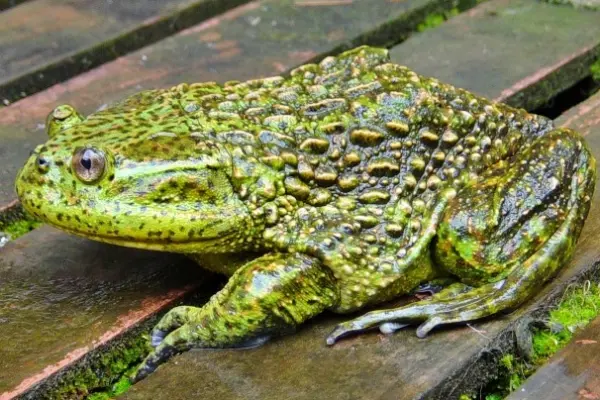
| Scientific name | Calyptocephalella gayi |
| Size | up to 32 cm, 13 in (females), 6 in (males) |
| Location | Central Chile and Argentina |
| Diet | fish, invertebrates, small birds, small mammals, and other frogs |
The Chilean Giant Frog is one of the largest amphibians in the world. This strong helmeted water toad has a wide head and a big mouth.
It can grow to a very big size, measuring up to 32 cm (13 in) for females and 15.5 cm (6 in) for males from the snout to the vent.
The average maximum weight ranges between 0.5-1 kg (1.1-2.2 lb); however, some can reach even 3 kg (6.6 lb). It exceeds other huge species like the Lake Junin Frog to become the largest anuran in the Americas.
8) Goliath Bullfrog
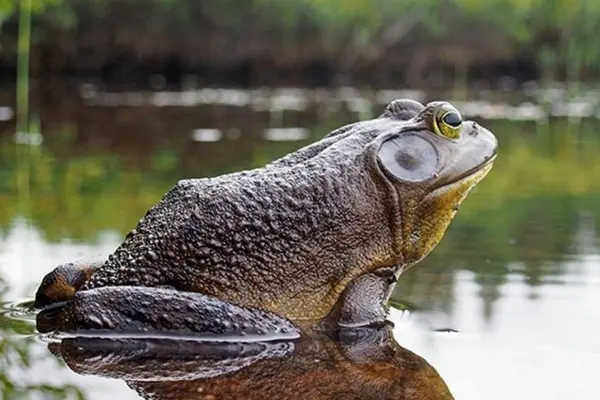
| Scientific name | Conraua goliath |
| Size | up to 32 cm |
| Location | Middle African Countries |
| Diet | fish, invertebrates, small birds, small mammals, and other frogs |
The next largest amphibian in the world is the largest living frog, the Goliath Bullfrog. Specimens can weigh up to 3.25 kg (7.2 lb) and reach a length from snout to vent of up to 32 cm (13 in).
Their huge size helps them to push rocks up to 2 kg in weight to create little dams for their nests and make astonishing 3 m jumps. The Goliath frog typically lives in or close to swift-moving rivers with sand bottoms.
7) Coastal Giant Salamander
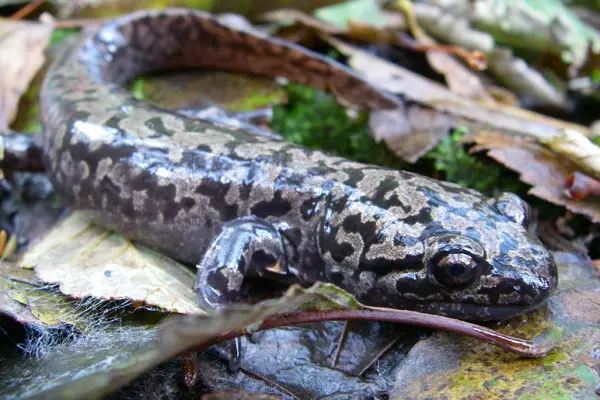
| Scientific name | Dicamptodon tenebrosus |
| Size | 34 cm (13 inches) |
| Location | Pacific Northwest (California, Oregon, British Columbia) |
| Diet | caddisflies, stoneflies, dipterans, beetles, benthos, small fish, and Tailed Frog larvae |
The coastal giant salamander is the largest terrestrial salamander in North America, growing to a maximum total length of 34 cm (13 inches).
Although color varies between individuals and communities, the dorsal surface among most adults is dark brown to nearly black and coated in light brown spots or marbling.
Pacific giant salamanders have medium-sized eyes with brass-freckled irises, short, blunt snouts, and somewhat broad skulls.
6) Lesser Siren
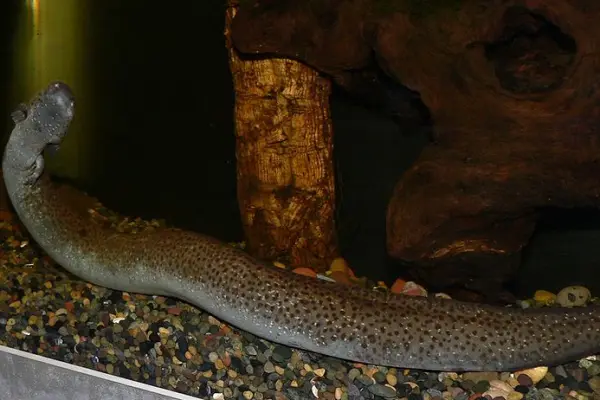
| Scientific name | Siren intermedia |
| Size | 17-69 cm, 7 to 27 inches |
| Location | northwestern and southwestern corners of Tennessee |
| Diet | aquatic invertebrates such as crustaceans, insects, worms, and snails |
The Lesser Siren, a lesser-known amphibian inhabiting North America, possesses distinct physical characteristics. Growing to an average length of 18-27 inches, it is relatively long compared to other aquatic salamanders.
Despite its length, it remains slender and lightweight, weighing around 100-200 grams. Its habitat primarily consists of freshwater bodies like swamps, marshes, and slow-moving streams, where it burrows into muddy substrates.
The Lesser Siren displays a unique coloration, featuring a dark gray or black body with lighter speckles or mottling.
It lacks hind limbs, instead sporting elongated forelimbs and external gills, facilitating its aquatic lifestyle. This elusive amphibian’s secretive nature adds to its allure and study-worthy characteristics.
5) Hellbender
| Scientific name | Cryptobranchus alleganiensis |
| Size | up to 29 inches (~74 cm) |
| Location | United States of America |
| Diet | crayfish and fish |
The hellbender is a giant amphibian that lives entirely in water. Typically, its body is a dark grey or brown color with scattered dark dots running along the back, and it has a flat head and wrinkly body.
The hellbender is the fifth heaviest amphibian on Earth, weighing four to five pounds (1.8 to 2.3 kg), making it the largest salamander in North America. Adults are generally 20 in length but may reach up to 29 inches.
4) Greater Siren
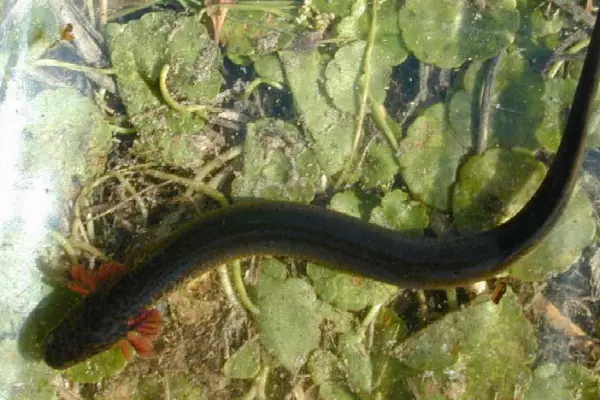
| Scientific name | Siren lacertina |
| Size | 7-38 inches |
| Location | Coastal Plains of Washington DC to Florida |
| Diet | insects, crustaceans, gastropods, bivalves, spiders, molluscs, fish, and crayfish |
Greater Sirens have small lungs and external gills throughout their entire lives but no hind limbs or pelvic girdles. They have an unfused pectoral girdle and possess no eyelids.
Greater Sirens hatch out at about 1.5 cm (0.59 in) in length and develop to lengths between 18 and 97 cm (7 to 38 inches).
Weight might vary between 55 to 1,000 g (1.9 to 35.3 oz). Although they come in a variety of colors, they are typically olive or grey in hue with tiny yellow or green spots on their flanks.
3) Japanese Giant Salamander
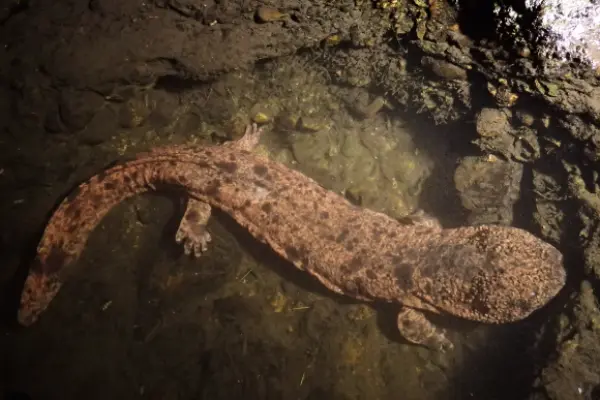
| Scientific name | Andrias japonicus |
| Size | up to 150 cm |
| Location | Southwest Japan |
| Diet | fish, insects, crayfish, snails, and small mammals |
The Japanese giant salamander is undoubtedly the third largest amphibian in the world, which can reach a maximum size of 5 ft (1.5 m) and 55 pounds (25 kg).
The Japanese Giant Salamander may blend in with stream and river bottoms thanks to its spotted brown and black skin.
The pattern of tubercles on the head and throat distinguishes the Japanese giant salamander from the Chinese giant salamander.
2) South China Giant Salamander
| Scientific name | Andrias sligoi |
| Size | 180 cm, (~6 ft) |
| Location | Southern China (Pearl River Basin) |
| Diet | crabs, insects, fish, worms, snails, lizards, frogs, snakes, small mammals, and even smaller salamanders |
In the second position, we have one of the largest living amphibians and also the largest salamander species, the South China Giant Salamander.
Now critically endangered or has been extinct in the wild, this species is a close relative to the Chinese Giant Salamander.
The largest species recorded measured up to 1.8 m (5.9 ft) and weighed nearly 40 kg. The Chinese Giant Salamander, on the other hand, grows up to 1.3 m long, with an average weight of 25-30 kg.
1. Chinese Giant Salamander
| Scientific name | Andrias davidianus |
| Size | 180 cm, (~6 ft) |
| Location | rocky, mountain rivers, and large streams in China |
| Diet | crabs, insects, fish, worms, snails, lizards, frogs, snakes, small mammals, and even smaller salamanders |
The largest known amphibian is the Chinese Giant Salamander with a total length of 180 cm. The Chinese Giant Salamander, an extraordinary creature endemic to China, is renowned for its impressive size and unique features.
As the largest salamander species in the world, it can reach lengths of up to 6 feet, making it a true giant. Weighing around 50 kg, it is a heavy amphibian with a robust body.
Its natural habitat includes rivers, streams, and mountainous regions, where it prefers clear, cool waters.
The Chinese Giant Salamander possesses rough, wrinkled skin that can vary in color from dark gray to mottled brown, allowing it to camouflage effectively. It is the largest or biggest known amphibian.
With its primitive appearance and critically endangered status, this majestic species has become a symbol of conservation efforts and the need to protect our natural world.
In conclusion, the world of amphibians holds an array of fascinating creatures, and among them, the top 10+ largest amphibians stand out for their impressive size and unique characteristics.
From the Chinese Giant Salamander, the largest of them all, to the Hellbender, these amphibians showcase the incredible diversity found in nature.
They inhabit a range of habitats, from rivers and streams to rainforests and marshes, adapting to their environments with remarkable physical adaptations.
As ambassadors of their ecosystems, these giants remind us of the importance of conservation and preserving the delicate balance of our planet’s amphibian biodiversity for future generations to marvel at.
References:
- Wikipedia
- The 10 Largest Frogs In The World by A-Z Animals
Also Read:

Meet Abhidept (nickname Monty), the visionary founder of How It See, being an engineering student, he’s fueled by an insatiable curiosity about the world around him. He is captivated by an eclectic correlation between animal groups, science, and nature, and this fascination drives his quest for understanding.
After completing his degree, he’s set on a mission to delve deep into the realm of nature, accumulating knowledge to share with you through his writing. In the meantime, he loves to watch anime and read anime.
